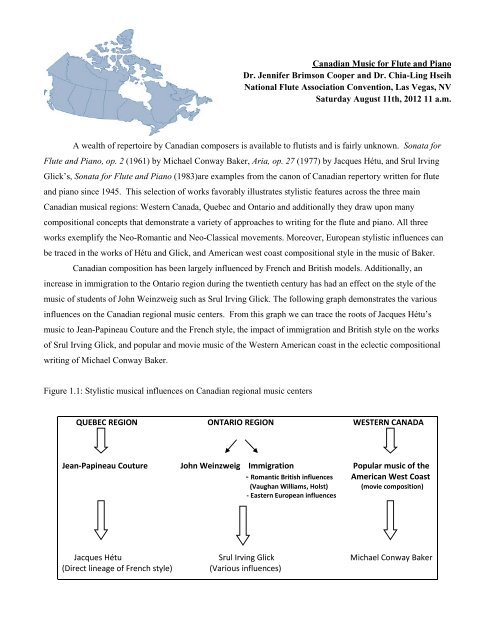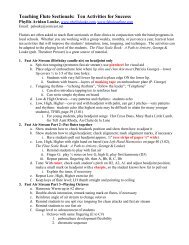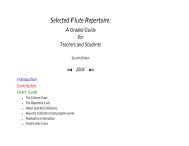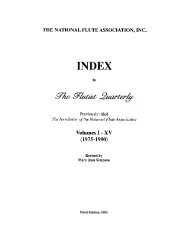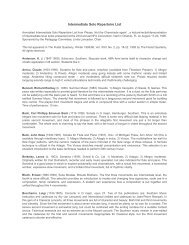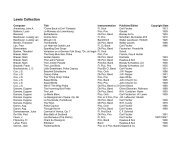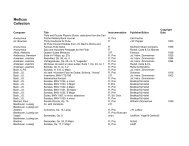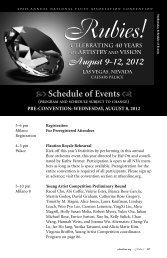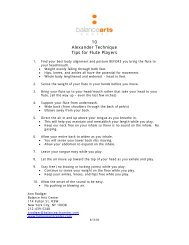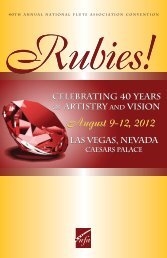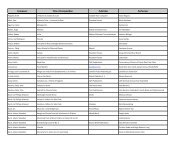Canadian Music for Flute and Piano Dr. Jennifer Brimson Cooper ...
Canadian Music for Flute and Piano Dr. Jennifer Brimson Cooper ...
Canadian Music for Flute and Piano Dr. Jennifer Brimson Cooper ...
Create successful ePaper yourself
Turn your PDF publications into a flip-book with our unique Google optimized e-Paper software.
<strong>Canadian</strong> <strong>Music</strong> <strong>for</strong> <strong>Flute</strong> <strong>and</strong> <strong>Piano</strong><br />
<strong>Dr</strong>. <strong>Jennifer</strong> <strong>Brimson</strong> <strong>Cooper</strong> <strong>and</strong> <strong>Dr</strong>. Chia-Ling Hseih<br />
National <strong>Flute</strong> Association Convention, Las Vegas, NV<br />
Saturday August 11th, 2012 11 a.m.<br />
A wealth of repertoire by <strong>Canadian</strong> composers is available to flutists <strong>and</strong> is fairly unknown. Sonata <strong>for</strong><br />
<strong>Flute</strong> <strong>and</strong> <strong>Piano</strong>, op. 2 (1961) by Michael Conway Baker, Aria, op. 27 (1977) by Jacques Hétu, <strong>and</strong> Srul Irving<br />
Glick’s, Sonata <strong>for</strong> <strong>Flute</strong> <strong>and</strong> <strong>Piano</strong> (1983)are examples from the canon of <strong>Canadian</strong> repertory written <strong>for</strong> flute<br />
<strong>and</strong> piano since 1945. This selection of works favorably illustrates stylistic features across the three main<br />
<strong>Canadian</strong> musical regions: Western Canada, Quebec <strong>and</strong> Ontario <strong>and</strong> additionally they draw upon many<br />
compositional concepts that demonstrate a variety of approaches to writing <strong>for</strong> the flute <strong>and</strong> piano. All three<br />
works exemplify the Neo-Romantic <strong>and</strong> Neo-Classical movements. Moreover, European stylistic influences can<br />
be traced in the works of Hétu <strong>and</strong> Glick, <strong>and</strong> American west coast compositional style in the music of Baker.<br />
<strong>Canadian</strong> composition has been largely influenced by French <strong>and</strong> British models. Additionally, an<br />
increase in immigration to the Ontario region during the twentieth century has had an effect on the style of the<br />
music of students of John Weinzweig such as Srul Irving Glick. The following graph demonstrates the various<br />
influences on the <strong>Canadian</strong> regional music centers. From this graph we can trace the roots of Jacques Hétu’s<br />
music to Jean-Papineau Couture <strong>and</strong> the French style, the impact of immigration <strong>and</strong> British style on the works<br />
of Srul Irving Glick, <strong>and</strong> popular <strong>and</strong> movie music of the Western American coast in the eclectic compositional<br />
writing of Michael Conway Baker.<br />
Figure 1.1: Stylistic musical influences on <strong>Canadian</strong> regional music centers<br />
QUEBEC REGION ONTARIO REGION WESTERN CANADA<br />
Jean-Papineau Couture John Weinzweig Immigration Popular music of the<br />
- Romantic British influences American West Coast<br />
(Vaughan Williams, Holst)<br />
(movie composition)<br />
- Eastern European influences<br />
Jacques Hétu Srul Irving Glick Michael Conway Baker<br />
(Direct lineage of French style) (Various influences)
Sonata <strong>for</strong> <strong>Flute</strong> <strong>and</strong> <strong>Piano</strong> Srul Irving Glick (1934-2002)<br />
Ontario region composer, Srul Irving Glick (1934-2002) primarily studied composition with Ontarian<br />
composer, John Weinzweig, but was also exposed to the works of Darius Milhaud <strong>and</strong> Max Deutsch during brief<br />
periods of study. Glick’s works are best known <strong>for</strong> their lyrical melodic writing, tonal thematic language <strong>and</strong><br />
range of tone color. His works have been heavily influenced by immigration, demonstrating the use of British<br />
folk-like <strong>and</strong> jig melodies <strong>and</strong> a lyrical ballad style of writing. Many of his works also bear a strong association<br />
with nature, <strong>and</strong> he is known <strong>for</strong> his inclusion of Jewish melodies within his compositions. These are all apparent<br />
in his Sonata <strong>for</strong> <strong>Flute</strong> <strong>and</strong> <strong>Piano</strong> (1981). Within the work Glick exploits lyricism <strong>and</strong> chromatic harmony<br />
illustrative of a Neo-Romantic style yet creatively employs it within a Neo-Classical framework. This infusion of<br />
Neo-Romantic <strong>and</strong> Neo-Classical contexts in Glick’s Sonata <strong>for</strong> <strong>Flute</strong> <strong>and</strong> <strong>Piano</strong>, echoes that of Baker’s Sonata<br />
<strong>for</strong> <strong>Flute</strong> <strong>and</strong> <strong>Piano</strong>, op.2.<br />
Aria, op. 27 Jacques Hétu (1938-2010)<br />
Jacques Hétu is one of Canada’s most prolific composers. Based in the Quebec region, he wrote in a<br />
variety of genres including solo, chamber <strong>and</strong> orchestral repertoire. His music has been directly influenced by the<br />
French style; much of his flute repertoire echoes the music of Olivier Messiaen, <strong>and</strong> Henri Dutilleux having been<br />
exposed to their French compositional stylistic guises during his studies with them in France in the early 1960’s.<br />
Hétu’s approach to writing <strong>for</strong> flute <strong>and</strong> piano includes a variety in articulation, creative use of range <strong>and</strong> dynamic<br />
contrasts, <strong>and</strong> an endless range of tone color <strong>and</strong> expression. His Aria, opus 27, is best described within a Neo-<br />
Romantic context in its tonal ambiguity, rich chromatic dissonance, linear musical motives with large leaps, <strong>and</strong><br />
intimate interaction between the solo flute <strong>and</strong> piano lines.<br />
Sonata <strong>for</strong> <strong>Flute</strong> <strong>and</strong> <strong>Piano</strong>, op. 2 Michael Conway Baker (b. 1937)<br />
Michael Conway Baker (b. 1937) is a <strong>Canadian</strong> composer of American birth based in Western Canada.<br />
His music is best characterized in terms of jazz <strong>and</strong> popular style melodies representative of the American West<br />
Coast. Western <strong>Canadian</strong> region stylistic traits found in his Sonata <strong>for</strong> <strong>Flute</strong> <strong>and</strong> <strong>Piano</strong> include idiomatic<br />
instances of jazz <strong>and</strong> popular style lyrical melodic lines; other regional stylistic traits demonstrate evidence of folk<br />
song influence. His Sonata <strong>for</strong> <strong>Flute</strong> <strong>and</strong> <strong>Piano</strong> demonstrates basic theme development with use of folk <strong>and</strong><br />
ballad-style melodic writing. Stylistic guises of both Neo-Classical <strong>and</strong> Neo-Romantic movements are evident in<br />
this work. Baker further exploits the Neo-Classical idiom in his Sonata <strong>for</strong> <strong>Flute</strong> <strong>and</strong> <strong>Piano</strong> in his <strong>for</strong>mal plan -<br />
the work is divided into the st<strong>and</strong>ard three-movement Classical framework of fast-slow-fast.
Chronological listing of flute works by notable Ontario composers: John Jacob Weinzweig, Harry<br />
Freedman, Harry Somers, R. Murray Schafer, Srul Irving Glick <strong>and</strong> Robert Aitken*<br />
SOLO FLUTE:<br />
Weinzweig Divertimento no. 1– Originally “Suite <strong>for</strong> <strong>Flute</strong> <strong>and</strong> String Orchestra” (1946)<br />
(<strong>Piano</strong> reduction by Harold Perry)<br />
Schafer Sonatina <strong>for</strong> <strong>Flute</strong> <strong>and</strong> Harpsichord (or <strong>Piano</strong>) (1958)<br />
London Premiere: William Bennett (fl) <strong>and</strong> Celia Bizony (1959)<br />
Glick<br />
Petite suite pour flute (1960) – <strong>Flute</strong> <strong>and</strong> <strong>Piano</strong><br />
Aitken <strong>Music</strong> <strong>for</strong> <strong>Flute</strong> <strong>and</strong> Electronic Tape (1963)<br />
Somers Etching – The Vollard Suite (from Picasso Suite) (1964)<br />
Commissioned by Saskatoon Symphony Orchestra<br />
Freedman Soliloquy (1970) – <strong>Flute</strong> <strong>and</strong> <strong>Piano</strong><br />
Weinzweig Riffs <strong>for</strong> solo flute (1974) – Premiere: Toronto, Robert Aitken<br />
Aitken<br />
Icicle (1977) – Solo flute<br />
Aitken<br />
Plainsong (1977) – Solo flute<br />
Glick Sonata <strong>for</strong> <strong>Flute</strong> <strong>and</strong> <strong>Piano</strong> (1983)<br />
Written <strong>for</strong> Suzanne Shulman <strong>and</strong> Valerie Tyron<br />
Glick Wedding Suite (1984)<br />
Schafer Concerto <strong>for</strong> <strong>Flute</strong> <strong>and</strong> Orchestra (1984)<br />
Written <strong>for</strong> Robert Aitken<br />
Weinzweig Birthday Notes (1987) – Premiere: Dianne Aitken <strong>and</strong> Kevin Fitz-Gerald<br />
Aitken<br />
Berceuse (For those who sleep be<strong>for</strong>e us) (1992) – <strong>Flute</strong> <strong>and</strong> Orchestra<br />
Somers<br />
Magic <strong>Flute</strong>. (1997) – <strong>Flute</strong> <strong>and</strong> tape<br />
Aitken Concerto <strong>for</strong> <strong>Flute</strong> <strong>and</strong> String Orchestra (Shadows V) (1999)<br />
Freedman Romp <strong>and</strong> Reverie (2002)<br />
Commissioned by Robert Cram<br />
Aitken Concerto <strong>for</strong> <strong>Flute</strong> <strong>and</strong> Orchestra (2009)<br />
Somers <strong>Music</strong> <strong>for</strong> Solo <strong>Flute</strong> ()<br />
Currently in editing process by Robert Cram<br />
CHAMBER WORKS:<br />
Weinzweig Intermissions <strong>for</strong> <strong>Flute</strong> <strong>and</strong> Oboe (1943)<br />
Premiere: Toronto, 23 October 1949– Dirk Keetbass (fl) <strong>and</strong> Harry Freedman<br />
Somers Woodwind Quintet (1948)<br />
Somers Trio (fl, vln, vlc) (1950)<br />
Schafer<br />
Concerto <strong>for</strong> harpsichord <strong>and</strong> eight wind instruments (2 fl, ob, hn, ob, bsn, cl,<br />
bscl, hrpsd) (1954)<br />
Somers Movement <strong>for</strong> Woodwind Quintet (1957)<br />
Aitken Quartet (fl, ob, vla, cb) (1961)<br />
Freedman Quintette (1962)<br />
Schafer Five Studies on Texts by Prudentius (sop, 4 fl) (1962)<br />
Premiere: Toronto, 1963 (pre-recorded) – Robert Aitken <strong>and</strong> Mary Morrison<br />
Schafer Diversions <strong>for</strong> Baroque Trio (fl, ob, harpsichord, tape) (1963)<br />
Premiere: Toronto, 1963 – Montreal Baroque Trio<br />
Glick Dance Concertante #2 (fl, cl, tpt, vlc, pn) (1964)
Weinzweig Woodwind Quintet (1964)<br />
Freedman Variations (fl, ob, harpsichord) (1965)<br />
Commissioned by the CBC <strong>for</strong> the Baroque Trio of Montreal<br />
Somers Kuyas: adapted from Louis Riel (sop, fl, perc) (1967)<br />
Commissioned by Institut International de Musique du Canada<br />
Freedman Toccata <strong>for</strong> <strong>Flute</strong> <strong>and</strong> Soprano (sop, fl) (1968)<br />
Written <strong>for</strong> Robert Aitken <strong>and</strong> Mary Morrison<br />
Schafer Enchantress (sop, exotic fl, 8 vlc) (1971)<br />
Premiere: Vancouver, 1972 – Robert Aitken, Mary Morrison <strong>and</strong> Vancouver<br />
Cello Club<br />
Freedman Tikki Tikki Tembo (woodwind quintet <strong>and</strong> narrator) (1971)<br />
Commissioned by the Dundas Public Library Board<br />
Aitken Kebyar (fl, cl, tb, 2 cb) (1973)<br />
Freedman Pan (sop, fl, pn) (1972)<br />
Commissioned by the CBC <strong>for</strong> the Lyric Arts Trio<br />
Freedman The Explainer (fl, ob, cl, perc, pn, <strong>and</strong> narrator) (1976)<br />
Commissioned by Days Months Years to Come through the Canada Council<br />
Aitken Shadows II: Lalitá (fl, 3 vlc, 2 perc, 2 hrp) (1973)<br />
Aitken Shadows III: Nira (fl, ob, vla, cb, pn, harpsichord) (1974-1976)<br />
Freedman Tsolum Summer (fl, perc, strings) (1976)<br />
Commissioned by Hamilton Philharmonic Institute through the Canada Council<br />
Freedman Monday Gig (woodwind quintet) (1978)<br />
Commissioned by McLean Foundation <strong>and</strong> Ontario Arts Council<br />
Freedman November (sop, fl, vibraphone, hrp) (1978)<br />
Freedman Opus Pocus (fl, vln, vla, vlc) (1979)<br />
Commissioned by the Galliard Ensemble through the Ontario Arts Council<br />
Glick Suite Hebraique No. 5 (fl, vln, cl, vlc) (1980)<br />
Aitken Folia (fl, ob, cl, hn, bsn) (1981)<br />
Aitken Monodie (K. Aitken) (SATB, fl) (1983)<br />
Weinzweig <strong>Music</strong> Centre Serenade (fl, hn, vla, vcl) (1984)<br />
Schafer Buskers (fl, vln, vla) (1985)<br />
Schafer Rounds(fl, vln, vla) (1985)<br />
Glick Trio <strong>for</strong> flute, viola <strong>and</strong> harp (1988)<br />
Aitken Shadows IV: My Song (2 fl, ensemble) (1994)<br />
Aitken My Song: Shadows IV (2fl, optional accomp: ob, bsn, vln, vlc) (1994)<br />
Freedman Touchpoints (fl, vla, hrp) (1994)<br />
Commissioned by Trio Lyra through the Ontario Arts Council<br />
Freedman Blue Light (fl, cl/bass cl, vln, vlc, pn) (1995)<br />
Commissioned by Aurora <strong>Music</strong>ale, Winnipeg<br />
Aitken Wedding Song (2 fl) (1999)<br />
Schafer Flew Toots <strong>for</strong> Two <strong>Flute</strong>s (2004)<br />
Written <strong>for</strong> the occasion of Aitken’s retirement from Freiburg, Germany<br />
*Scores are available <strong>for</strong> purchase or loan through the <strong>Canadian</strong> <strong>Music</strong> Centre:<br />
http://www.musiccentre.ca/home.cfm


